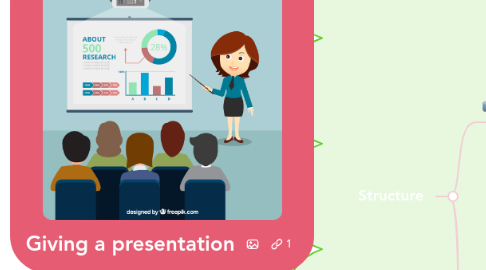
1. Before you start
1.1. 1. Find out the information
1.1.1. library
1.1.2. online
1.2. 2. Explain difficult words
1.3. 3. Think about a logical way of doing your presentation
2. Tips & rules
2.1. 1. Use graphics
2.1.1. pictures
2.1.2. charts
2.1.3. videos
2.2. 2. Choose a clearly legible font size
2.3. 3. Don't use too many colours or special effects
2.4. 4. Prepare little note cards
2.4.1. only write a few words
2.4.2. NEVER write whole sentences
2.5. 5. Use short and simple sentences
2.6. 6. Make breaks between sentences
2.7. 7. Eye contact
2.8. 8. Practise your presentation at home
3. Structure
3.1. INTRODUCTION
3.1.1. 1. Say hello to your listeners
3.1.1.1. Good morning / afternoon.
3.1.1.2. Hello.
3.1.2. 2. (Introduce yourself)
3.1.2.1. My name is ...
3.1.2.2. I'm ...
3.1.3. 3. Introduce your topic
3.1.3.1. Today I'm going to talk about ...
3.1.3.2. My presentation is about ...
3.1.3.3. My topic is ...
3.1.4. 4. Say WHY you have chosen this topic
3.1.4.1. I've chosen this topic because ...
3.1.4.1.1. I'm a big fan of ...
3.1.4.1.2. I'm totally into ...
3.1.4.1.3. ... is my favourite
3.1.5. 5. Show your main points
3.1.5.1. board
3.1.5.2. screen
3.1.5.3. poster
3.1.6. 6. Outline the structure
3.1.6.1. First I'm going to talk about ...
3.1.6.2. Then I'll tell you a bit about ...
3.1.6.3. Finally I'll say a few words about ...
3.1.7. 7. Tell your listeners how you want to deal with questions
3.1.7.1. during the presentation
3.1.7.1.1. If you have any questions, feel free to interrupt!
3.1.7.2. after the presentation
3.1.7.2.1. If you don't mind we'll leave questions till the end.
3.2. MAIN PARTS
3.2.1. Tell your audience what you know about your topic
3.3. ENDING
3.3.1. (Summarize your main points)
3.3.2. Thank people for their attention
3.3.2.1. Thank you for
3.3.2.1.1. your attention!
3.3.2.1.2. listening!
3.3.3. (Prepare a handout)
